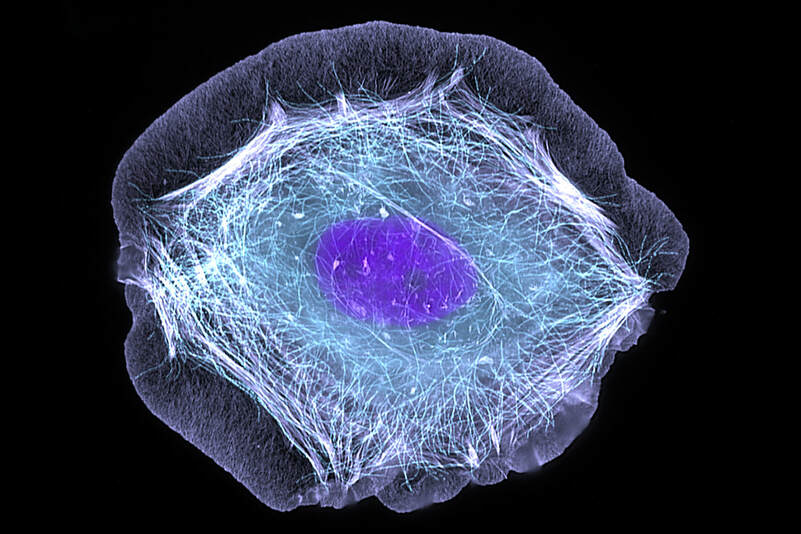The Effect of Cellular Aging on Heart Disease and Diabetes
From external changes such as wrinkles to internal changes such as the stiffening of arteries, aging affects every part of a person’s body. On the cellular level, a process called cellular senescence occurs. Cells have a limited “lifespan”, referring to the number of divisions they can undergo before stopping. The lifespan of a cell is determined by DNA sequences at the ends of the a chromosome, known as telomeres. Telomeres protect cells from losing the ends of their DNA sequences during cellular division, but wear down more and more each time the cell divides. Once the telomeres are gone, which takes about 55 cellular divisions, the cells hit what is called the Hayflick limit, and stop dividing. Instead, they start secreting chemical compounds known as senescence-associated secretory phenotypes (SASP) that trigger an immune response and can cause the tissues around the now-senescent cell to become inflamed. As one might expect, older adults have a larger proportion of senescent cells compared to younger adults. A group of researchers from the University of Antwerp in Belgium has performed a review of articles correlating cellular senescence and diseases common in older adults, and has demonstrated possible links between aging, diabetes, and cardiovascular diseases, due to the SASP.
Researchers primarily explored the relationship between diabetes (both types 1 and 2) and cellular senescence. They found that both could influence each other in a cycle, in which senescent cells would damage tissues and pancreatic cells, leading to the onset of type-2 diabetes. Furthermore, type-1 diabetes, which can affect people at a young age, causes more senescent cells to accumulate in the body due to the damage to fats and blood glucose levels that occur as a result of the disease. Researchers were also able to link aging and diabetes through the telomere length of cells. Both aging and diabetes cause patients to have shorter than normal telomeres, thus resulting in more senescent cells. Senescent cells have also been shown to trigger an inflammatory response in the surrounding tissue, and ultimately cause neighboring cells to become senescent as well.
Senescent cells are also a major part of plaque formation in arteries in a process known as atherosclerosis. When cholesterol gets into the inner lining of a vessel, it triggers an inflammatory response. The inflammatory response triggers further development and maturation of the plaque, causing increased risk of heart attacks. The SASP released by senescent cells has a similar pathway in the body as the inflammatory response to cholesterol, so having more senescent cells may worsen plaque formation.
Researchers primarily explored the relationship between diabetes (both types 1 and 2) and cellular senescence. They found that both could influence each other in a cycle, in which senescent cells would damage tissues and pancreatic cells, leading to the onset of type-2 diabetes. Furthermore, type-1 diabetes, which can affect people at a young age, causes more senescent cells to accumulate in the body due to the damage to fats and blood glucose levels that occur as a result of the disease. Researchers were also able to link aging and diabetes through the telomere length of cells. Both aging and diabetes cause patients to have shorter than normal telomeres, thus resulting in more senescent cells. Senescent cells have also been shown to trigger an inflammatory response in the surrounding tissue, and ultimately cause neighboring cells to become senescent as well.
Senescent cells are also a major part of plaque formation in arteries in a process known as atherosclerosis. When cholesterol gets into the inner lining of a vessel, it triggers an inflammatory response. The inflammatory response triggers further development and maturation of the plaque, causing increased risk of heart attacks. The SASP released by senescent cells has a similar pathway in the body as the inflammatory response to cholesterol, so having more senescent cells may worsen plaque formation.
Image Source: Ein frischer geöffneter Granatapfel auf schwarzem Hintergrund by Marco Verch is licensed under CC BY 2.0
Senescent cells have been shown to influence diabetes and heart disease, but what causes cells to become senescent? Time is a major factor, as telomeres get shorter each time a cell divides. Another factor, the researchers, found, may be oxidative stress, which is a condition in which body cells are damaged by free radicals. Free radicals are compounds that steal electrons from other compounds in a processes called oxidation, and can damage DNA, protein, and other crucial materials in the body. Though researchers are not yet sure how oxidative stress causes more senescent cells to develop, they have found an association between increased oxidative stress and more senescent cells. A way of combating free radicals is by eating antioxidant foods, which provide electrons for free radicals to take, sparing the rest of the body from damage. These foods include pomegranates, blueberries, sweet potatoes, and many more. These foods contain vitamins that reduce oxidative damage and thus reduce the risk of developing the chronic diseases associated with cellular senescence as well. As researchers continue to study the link between cellular senescence and disease, more and more will become known about the body’s normal and pathological changes as we age, as well as how to cure these diseases and improve quality of life.
Featured Image Source: Skin cell (keratinocyte) by Zeiss Microscopy is licensed under CC BY-MC-ND 2.0
RELATED ARTICLES
|
Vertical Divider
|
Vertical Divider
|
Vertical Divider
|






